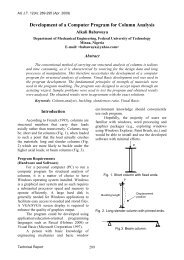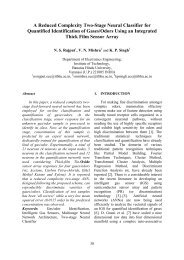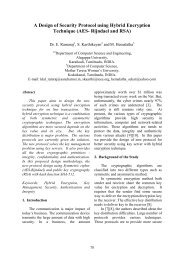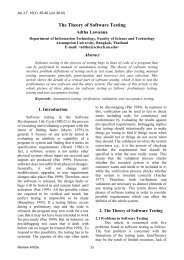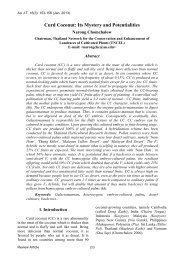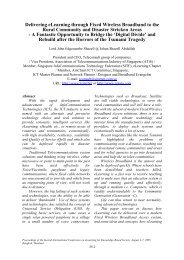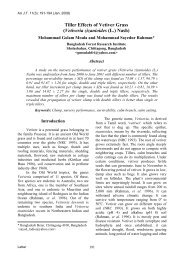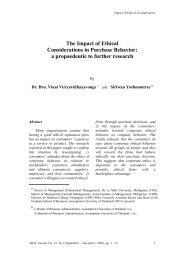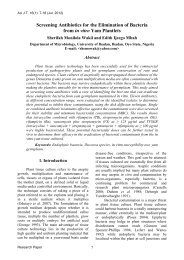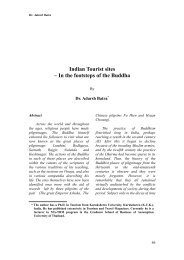Production of Tannin from the Bark of Eucalyptus ... - AU Journal
Production of Tannin from the Bark of Eucalyptus ... - AU Journal
Production of Tannin from the Bark of Eucalyptus ... - AU Journal
Create successful ePaper yourself
Turn your PDF publications into a flip-book with our unique Google optimized e-Paper software.
<strong>Production</strong> <strong>of</strong> <strong>Tannin</strong> <strong>from</strong> <strong>the</strong> <strong>Bark</strong> <strong>of</strong> <strong>Eucalyptus</strong> camadulensis<br />
K. R. Onifade<br />
Department <strong>of</strong> Chemical Engineering<br />
Federal University <strong>of</strong> Technology, Minna, Nigeria<br />
Abstract<br />
<strong>Tannin</strong> is a very versatile industrial material found in many parts <strong>of</strong> plants such as<br />
<strong>the</strong> bark <strong>of</strong> <strong>Eucalyptus</strong> camadulensis (EC). The bark <strong>of</strong> EC that normally peels <strong>of</strong>f during<br />
<strong>the</strong> dry season has usually served as anxious substrate for pathogens.<br />
In <strong>the</strong> present experiment, tannin was leached <strong>from</strong> <strong>the</strong> bark <strong>of</strong> EC using water<br />
as solvent. <strong>Tannin</strong> produced varied <strong>from</strong> 5 to 12%. The yield obtained was found to<br />
vary inversely with <strong>the</strong> particle size <strong>of</strong> <strong>the</strong> bark. Better yields were obtained if distilled<br />
water and agitation method were used in comparison with tap water and soaking<br />
method. However, <strong>the</strong> increase in yield was not statistically significant. Method <strong>of</strong><br />
solvent removal and doubling <strong>the</strong> amount <strong>of</strong> solvent used has little or no effect on yield.<br />
Keywords: <strong>Tannin</strong>, bark, <strong>Eucalyptus</strong> camadulensis, distilled water, tap water.<br />
pulp; oxalic acid (Onifade 1990; Onifade 1997)<br />
Introduction<br />
<strong>Eucalyptus</strong> is a large genus <strong>of</strong> mostly large<br />
trees <strong>of</strong> <strong>the</strong> Family Myrtaceae (Order Myrtales)<br />
which is native to Australia, New Zealand and<br />
Tasmania. There are about 600 species based<br />
largely on <strong>the</strong>ir bark characteristics. The bark is<br />
ei<strong>the</strong>r smooth or rough with varying degrees in<br />
each class. <strong>Eucalyptus</strong> camadulensis (EC) is one<br />
<strong>of</strong> <strong>the</strong> most common eucalypti (Anon. 1973;<br />
Anon. 1979; Anon. 1989).<br />
EC, also called “river red gum”, was <strong>the</strong> first<br />
species introduced to Nigeria in 1916. Since <strong>the</strong>n<br />
it has adapted and thrived well because its<br />
plantation requires non-expensive inputs for<br />
propagation. There is a large plantation in Afaka,<br />
Kaduna State. Nigeria has also recorded <strong>the</strong> best<br />
yield <strong>of</strong> eucalyptus trees in Africa (Jamieson 1967;<br />
Keay 1989).<br />
<strong>Eucalyptus</strong> trees are essentially utilized as<br />
fuels, as timber in construction and poles for<br />
electricity and telecommunication transmission line<br />
(Anon. 1979; Anon. 1994). These primary uses<br />
have made <strong>the</strong>m important component <strong>of</strong> third<br />
world economies. They have also been exploited<br />
commercially for apiculture; production <strong>of</strong> wood<br />
and essential oils; for making ornamentals (due to<br />
<strong>the</strong>ir colorful flowers); and incorporated into<br />
inhalants (Anon. 1979; Evans 1989).<br />
<strong>Tannin</strong> is a general term for a widely<br />
occurring group <strong>of</strong> substances <strong>of</strong> vegetable origins<br />
which occur in oak gallnuts, tea and barks <strong>of</strong><br />
‘Suma’ oak mangrove (Fahn 1982). It also occurs<br />
in some <strong>of</strong> <strong>the</strong> eucalyptus trees such as EC (Esau<br />
1965). It is a light to brown amorphous granular<br />
powder with <strong>the</strong> chemical formula C 76 H 52 O 10,<br />
which decomposes at 210-215 o C. There are two<br />
types <strong>of</strong> tannin, namely, <strong>the</strong> condensable and <strong>the</strong><br />
hydrolyzable (Godwin and Mercier 1983). In <strong>the</strong><br />
former, <strong>the</strong> benzene nuclei are joined to <strong>the</strong> larger<br />
complex by carbon linkages, while in <strong>the</strong> latter,<br />
<strong>the</strong>y are joined by oxygen atoms.<br />
Condensable tannins are largely polymeric<br />
condensation products <strong>of</strong> catechin or catechin- like<br />
substances. They cannot be hydrolyzed by acids<br />
or enzymes, but condense readily to lower<br />
molecular-weight tannins.<br />
Hydrolyzable tannins decompose in water,<br />
with which <strong>the</strong>y react to form o<strong>the</strong>r useful<br />
substances such as garlic acid, pyrotocatechi acid
and sugar. Gallotannin, <strong>the</strong> best-known<br />
hydrolyzable tannin, is extracted by treating<br />
Turkish or Chinese nutgall with water or organic<br />
solvents.<br />
<strong>Tannin</strong>s have diverse uses (Austin 1994).<br />
The traditional use is for rendering raw hides into<br />
lea<strong>the</strong>r. But <strong>the</strong>y have also been employed<br />
industrially in denaturing alcohol; in aqueous<br />
solution for treating burns and protecting plant<br />
against dehydration and damage by animals; as<br />
mordants on dyeing; as antidote for metallic,<br />
alkaloid and glycoside poisons; and as reagents in<br />
photography. They are also added to mud in oil<br />
drilling operation to increase <strong>the</strong> viscosity and have<br />
been used for <strong>the</strong> manufacture <strong>of</strong> ink, rubber and<br />
plastics; for preventing sculling in hot waters; for<br />
ores flotation and water treatment; and by<br />
combining <strong>the</strong>m with binding agents such as<br />
polyvinyl pyrrolidone (PVP) to clarify wine and<br />
beer.<br />
Due to <strong>the</strong> dangers posed by <strong>the</strong><br />
environment <strong>from</strong> wastes in various forms, <strong>the</strong>re<br />
has been a new research focus in <strong>the</strong> effective<br />
utilization <strong>of</strong> chemical and agricultural by-products<br />
that have hi<strong>the</strong>rto been regarded as wastes. It is<br />
also a step in <strong>the</strong> right direction <strong>of</strong> a new initiative<br />
called “ZERI option” which discusses <strong>the</strong> use <strong>of</strong><br />
waste or pollutants <strong>from</strong> one system as raw<br />
materials in ano<strong>the</strong>r system (Agho 1999). The<br />
bark <strong>of</strong> EC normally peels <strong>of</strong>f during <strong>the</strong> dry<br />
season and litter <strong>the</strong> plantation, serving as ready<br />
substrate for pathogens.<br />
The objective <strong>of</strong> this work is to explore <strong>the</strong><br />
possibility <strong>of</strong> a commercial production <strong>of</strong> tannin<br />
<strong>from</strong> <strong>the</strong> bark <strong>of</strong> EC.<br />
Experimental Work<br />
The bark <strong>of</strong> EC was dried, ground and<br />
classified into different sizes using a sieve shaker.<br />
An amount <strong>of</strong> 0.5 kg <strong>of</strong> <strong>the</strong> ground bark was taken<br />
<strong>from</strong> each size range and put in a beaker. Tap or<br />
distilled water was added and <strong>the</strong> mixture agitated<br />
or soaked for a period <strong>of</strong> time. The resulting<br />
solution was filtered and tannin was recovered as<br />
flakes <strong>from</strong> <strong>the</strong> filtrate by distilling <strong>of</strong>f <strong>the</strong> solvent or<br />
evaporating it in an open beaker. The temperature<br />
<strong>of</strong> <strong>the</strong> heating medium was adjusted when <strong>the</strong><br />
tannin started forming as flakes. The tannin<br />
content <strong>of</strong> <strong>the</strong> extracts was compared by using a<br />
colorimeter to measure <strong>the</strong> absorption factor (at<br />
wavelength <strong>of</strong> 540 nm) <strong>of</strong> a prepared solution <strong>of</strong><br />
<strong>the</strong> extract to which ferric chloride was added.<br />
Table 1 gives <strong>the</strong> experimental data for <strong>the</strong><br />
operating variables. It shows that <strong>the</strong> variables<br />
investigated were particle size distribution, leaching<br />
time, type <strong>of</strong> solvent, method <strong>of</strong> leaching and<br />
method <strong>of</strong> solvent removal.<br />
Results and Discussion<br />
Tables 2 to 4 show <strong>the</strong> yield and yield<br />
percent for <strong>the</strong> different experimental runs. The<br />
yields for smaller-sized samples were greater than<br />
those <strong>of</strong> larger-sized samples. This is in<br />
consonance with mass transfer <strong>the</strong>ory because <strong>the</strong><br />
former present higher interfacial area between <strong>the</strong><br />
solvent and solute. The solution <strong>of</strong> tannin<br />
produced has pH <strong>of</strong> 6.0. It is <strong>the</strong>refore acidic as<br />
expected.<br />
Table 2 and 3 were obtained using <strong>the</strong> same<br />
operating parameters, except for <strong>the</strong> leaching<br />
solvent. Tap water was used for <strong>the</strong> set <strong>of</strong><br />
experiments in Table 2 while distilled water used<br />
for that in Table 3. From Fig.1, it can be clearly<br />
seen that <strong>the</strong> yields obtained for 1 hr were bigger<br />
in Table 2 than in Table 3. The same holds for<br />
o<strong>the</strong>r leaching times. The absorption factors <strong>of</strong> <strong>the</strong><br />
extracts in EXPTA were higher than those <strong>of</strong><br />
EXPTB. A typical value <strong>of</strong> <strong>the</strong> absorption factors<br />
is shown in Table 6. Since tap water was used in<br />
EXPTA, this implies that tannin may have<br />
contained higher impurities that <strong>the</strong> tannin <strong>of</strong><br />
EXPTB. However, when <strong>the</strong> statistical<br />
comparison <strong>of</strong> <strong>the</strong> results for EXPTA and EXPTB<br />
(typified by EXPTA1 and EXPTB1) is done as in<br />
Table 7, it could be seen that <strong>the</strong> difference in yield<br />
is not appreciable because <strong>the</strong> correlation<br />
coefficient is close to 1.0.<br />
Fig. 2 compares <strong>the</strong> yield <strong>of</strong> EXPTA for 3<br />
hours with that <strong>of</strong> EXPTC for 6 hrs. It was
expected that <strong>the</strong> yield for 6 hrs should be<br />
considerably higher. This was not so except for<br />
sample size range 250-500 (x 10 -6 m). Agitation<br />
was employed in EXPTA while soaking was used<br />
in EXPTC. Since agitation increases <strong>the</strong> rate <strong>of</strong><br />
mass transfer <strong>of</strong> material <strong>from</strong> <strong>the</strong> surface <strong>of</strong> <strong>the</strong><br />
solute to <strong>the</strong> bulk <strong>of</strong> <strong>the</strong> solution, <strong>the</strong> only plausible<br />
reason for <strong>the</strong> small difference in yield could be<br />
attributed to <strong>the</strong> method <strong>of</strong> leaching. The effect is<br />
even more discernible in <strong>the</strong> sample size above<br />
850 x 10 -6 m where <strong>the</strong> yields for 3 hrs were even<br />
higher than that for 6 hrs. The statistical<br />
comparison <strong>of</strong> EXPTA3 and EXPTC1 in Table 7<br />
shows that <strong>the</strong> difference in yield is not very<br />
appreciable as <strong>the</strong> correlation coefficient is close to<br />
1.0.<br />
The effect <strong>of</strong> volume <strong>of</strong> solvent can be seen<br />
<strong>from</strong> Fig. 3 where <strong>the</strong> tannin yields for EXPTC1<br />
and EXPTD1 were compared. It can be seen that<br />
<strong>the</strong>re was not much difference in yields showing<br />
that <strong>the</strong> effect <strong>of</strong> volume is not very appreciable.<br />
This is also confirmed by <strong>the</strong> statistical analysis <strong>of</strong><br />
results <strong>of</strong> EXPTC1 and EXPTD1 in Table 7<br />
where <strong>the</strong> correlation coefficient is close to 1.0.<br />
Conclusion<br />
<strong>Tannin</strong> has been confirmed to be present in<br />
EC bark and a yield <strong>of</strong> between 5 and 12% was<br />
obtained. If <strong>the</strong> large plantation <strong>of</strong> EC (where it is<br />
cultivated) is taken into account, <strong>the</strong> amount <strong>of</strong><br />
tannin that can be produced is substantial. The effect<br />
which operating parameters have on yield <strong>of</strong> tannin<br />
was discussed. It shows that fur<strong>the</strong>r investigation<br />
may be necessary to optimize <strong>the</strong> operating<br />
parameters for pr<strong>of</strong>itable design <strong>of</strong> a plant to<br />
exploit <strong>the</strong> production <strong>of</strong> tannin <strong>from</strong> <strong>the</strong> bark <strong>of</strong><br />
EC.<br />
References<br />
Agho, M.O, 1999. Pollution management and<br />
control: The zero emission option. Proc.<br />
Seminar on Environmental Pollution<br />
Management and Control, organized by<br />
Nigerian Society <strong>of</strong> Chemical Engineers,<br />
ABBYGOT Chapter, Gombe, Nigeria, July<br />
1999, pp 1-8.<br />
Anonymous. 1973. Eucalypti for Planting. FAO,<br />
Rome.<br />
Anonymous. 1979. Encyclopedia Americana, Vol<br />
10, p. 648; Vol. 21, p. 69. Grolier Inc.,<br />
Danbury, Connecticut, USA.<br />
Anonymous. 1989. Encyclopedia <strong>of</strong> Polymer<br />
Science and Eng., Vol. 17, 2 nd ed. pp 871-2.<br />
Wiley Interscience Publ., New York.<br />
Anonymous. 1994. Encyclopedia Britanica:<br />
Macropedia: Knowledge in Depth. Vol 4, p.<br />
588; Vol. 13, p. 692.<br />
Austin, A.G. 1994. Shreve’s Chemical Process<br />
Industries, 5 th ed. McGraw Hill, New York.<br />
Esau, K. 1965. Plant Anatomy, 2 nd ed. pp 27-30.<br />
Wiley, New York.<br />
Evans, B.R. 1989. Encyclopedia <strong>of</strong> Science and<br />
Technology, 5 th ed. McGraw Hill, New York.<br />
Fahn, A. 1982. Plant Anatomy, 3 rd ed., Pergamon<br />
Press, New York.<br />
Godwin, T.W.; and Mercier, E.I. 1983.<br />
Introduction to Plant Biochemistry, 2 nd ed.,<br />
Pergamon Press, Oxford, UK.<br />
Jamieson, B.G.M. 1967. Tropical Plant Types.<br />
Pergamon Press, Oxford, UK.<br />
Keay, R.W.J. 1989. Tree <strong>of</strong> Nigeria. p. 78.<br />
Oxford Science Publ., Oxford, UK.<br />
Onifade, K.R. 1990. Local souring <strong>of</strong> raw<br />
materials - A case study <strong>of</strong> oxalic acid. Paper<br />
presented at <strong>the</strong> seminar organized by Chemical<br />
Engineering Department, Ahmadu Bello<br />
University, Zaria, Nigeria and Nigerian Society <strong>of</strong><br />
Chemical Engineers, Kaduna State Chapter,<br />
August 1990.<br />
Onifade, K.R. 1997. Effect <strong>of</strong> Operating Variables<br />
on <strong>the</strong> <strong>Production</strong> <strong>of</strong> Oxalic Acid <strong>from</strong> <strong>the</strong> <strong>Bark</strong><br />
<strong>of</strong> <strong>Eucalyptus</strong> camadulensis. Paper presented<br />
at <strong>the</strong> 4 th Annual Conference <strong>of</strong> Kaduna<br />
Polytechnic College <strong>of</strong> Engineering Conference<br />
Series, Kaduna, Nigeria, 11-12 December<br />
1997.<br />
Acknowledgement
The author is indebted to his employer,<br />
Federal University <strong>of</strong> Technology, Minna for<br />
providing <strong>the</strong> academic environment for conducting<br />
<strong>the</strong> research. The help rendered by <strong>the</strong> technical<br />
staff and undergraduate students, especially<br />
Messrs. Adamu, Aliyu, Abubakar and Orekoya <strong>of</strong><br />
<strong>the</strong> Department <strong>of</strong> Chemical Engineering <strong>of</strong> <strong>the</strong><br />
Federal University <strong>of</strong> Technology, Minna is also<br />
amply acknowledged.<br />
Table 1. Experimental data for <strong>the</strong> operating variables.<br />
Leaching Volume Method<br />
time <strong>of</strong> solvent Leaching <strong>of</strong> solvent<br />
(hrs) Solvent (x 10- 6 m 3 ) method removal<br />
EXPTA1 1 Tap water 1000 Agitation Distillation<br />
EXPTA2 2 Tap water 1000 Agitation Distillation<br />
EXPTA3 3 Tap water 1000 Agitation Distillation<br />
EXPTB1 1 Distilled water 1000 Agitation Distillation<br />
EXPTB2 2 Distilled water 1000 Agitation Distillation<br />
EXPTB3 3 Distilled water 1000 Agitation Distillation<br />
EXPTC1 6 Tap water 1000 Soaking Distillation<br />
EXPTC2 12 Tap water 1000 Soaking Distillation<br />
EXPTC3 24 Tap water 1000 Soaking Distillation<br />
EXPTD1 6 Tap water 2000 Soaking evaporation<br />
EXPTD2 12 Tap water 2000 Soaking evaporation<br />
EXPTD3 24 Tap water 2000 Soaking evaporation<br />
Table 2. Yield and percentage <strong>of</strong> tannin for EXPTA.<br />
EXPTA1 EXPTA2 EXPTA3<br />
Sample Size Yield % Yield % Yield %<br />
(x 10 -6 m) (x 10 -3 kg) Yield (x 10 -3 kg) Yield (x 10 -3 kg) Yield<br />
250 – 500 3.80 7.6 3.88 7.8 3.87 7.7<br />
500 – 710 3.72 7.4 3.72 7.4 3.85 7.7<br />
710 – 850 3.66 7.3 3.69 7.4 3.71 7.4<br />
850 – 1000 3.61 7.1 3.63 7.3 3.67 7.3<br />
> 1000 3.57 7.1 3.57 7.1 3.59 7.2<br />
Table 3. Yield and percentage <strong>of</strong> tannin for EXPTB.<br />
EXPTB1 EXPTB2 EXPTB3<br />
Sample Size Yield % Yield % Yield %<br />
(x 10 -6 m) (x 10 -3 kg) Yield (x 10 -3 kg) Yield (x 10 -3 kg) Yield<br />
250 – 500 2.97 5.9 3.20 6.4 3.50 7.0
500 – 710 2.65 5.3 2.81 5.6 2.94 5.9<br />
710 – 850 2.50 5.0 2.73 5.5 2.80 5.6<br />
850 – 1000 2.23 4.5 2.38 4.8 2.59 5.2<br />
> 1000 2.01 4.0 2.20 4.4 2.41 4.8<br />
Table 4. Yield and percentage <strong>of</strong> tannin for EXPTC.<br />
EXPTC1 EXPTC2 EXPTC3<br />
Sample Size Yield % Yield % Yield %<br />
(x 10 -6 m) (x 10 -3 kg) Yield (x 10 -3 kg) Yield (x 10 -3 kg) Yield<br />
250 – 500 4.59 9.2 4.99 10.0 5.69 11.4<br />
500 – 710 3.89 7..8 4.89 9.8 5.31 10.6<br />
710 – 850 3.74 7.5 4.90 9.8 5.05 10.1<br />
850 – 1000 3.04 6.1 3.60 7.2 4.99 10.0<br />
> 1000 1.90 3.8 3.57 7.1 4.15 8.3<br />
Table 5. Yield and percentage <strong>of</strong> tannin for EXPTD.<br />
EXPTD1 EXPTD2 EXPTD3<br />
Sample Size Yield % Yield % Yield %<br />
(x 10 -6 m) (x 10 -3 kg) Yield (x 10 -3 kg) Yield (x 10 -3 kg) Yield<br />
250 – 500 5.81 11.6 5.88 11.7 6.10 12.2<br />
500 – 710 4.82 9.6 5.32 10.6 5.44 10.9<br />
710 – 850 4.62 9.2 5.11 10.2 5.27 10.5<br />
850 – 1000 4.59 9.2 5.03 10.1 5.00 10.0<br />
> 1000 3.46 6.9 3.87 7.7 3.95 7.9<br />
Table 6. Absorption factors for EXPTA1 and EXPTB1.<br />
Absorption factor<br />
Particle size (x 10 -6 m) EXPTA1 EXPTB1<br />
250 - 500 3.29 2.95<br />
500 - 710 3.27 2.91<br />
710 - 850 3.25 2.86<br />
850 - 1000 3.23 2.82<br />
> 1000 3.21 2.76
Table 7. Statistical comparison <strong>of</strong> yields.<br />
Experimental runs compared<br />
Correlation coefficient<br />
EXPTA1 and EXPTB1 0.99<br />
EXPTA1 and EXPTC1 0.93<br />
EXPTC1 and EXPTD1 0.96
4.00<br />
3.50<br />
3.00<br />
<strong>Tannin</strong> yield (x 10 -3 Kg)<br />
2.50<br />
2.00<br />
1.50<br />
1.00<br />
EXPTA1<br />
EXPTB1<br />
0.50<br />
0.00<br />
250 - 500 500 - 710 710 - 850 850 - 1000 > 1000<br />
Sample Size (x 10 -6 m)<br />
Fig . 1. Comparison <strong>of</strong> tannin yields for EXPTA 1 and EXPTB 1<br />
5.00<br />
4.50<br />
4.00<br />
3.50<br />
<strong>Tannin</strong> yield (x 10 -3 kg)<br />
3.00<br />
2.50<br />
2.00<br />
1.50<br />
1.00<br />
EXPTA3<br />
EXPTC1<br />
0.50<br />
0.00<br />
250 - 500 500 - 710 710 - 850 850 - 1000 > 1000<br />
Sample size (x 10 -6 m)<br />
Fig. 2. Comparison <strong>of</strong> tannin yields for EXPTA3 and EXPTC1
6.00<br />
5.00<br />
<strong>Tannin</strong> yield (x 10 -3 kg)<br />
4.00<br />
3.00<br />
2.00<br />
EXPTC1<br />
EXPTD1<br />
1.00<br />
0.00<br />
250 - 500 500 - 710 710 - 850 850 - 1000 > 1000<br />
Sample size (x 10 -6 m)<br />
Fig. 3. Comparison <strong>of</strong> tannin yields for EXPTC1 and EXPTD1



